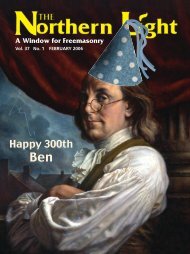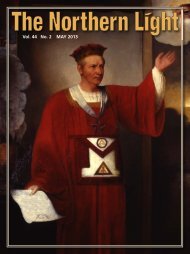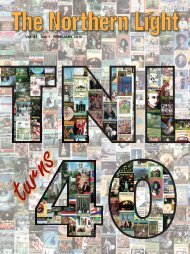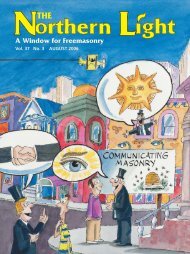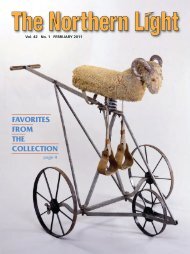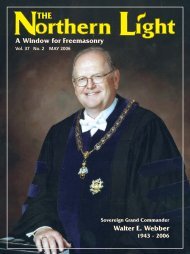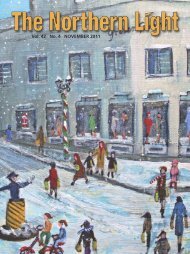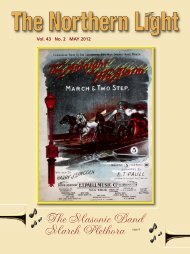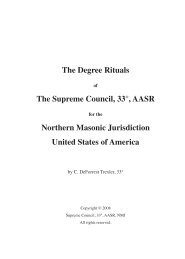May - Scottish Rite
May - Scottish Rite
May - Scottish Rite
You also want an ePaper? Increase the reach of your titles
YUMPU automatically turns print PDFs into web optimized ePapers that Google loves.
Timeline of Cerneau’s Activities<br />
In the 1780s Cerneau was a lodge member (and later, Secretary) in Haiti. During the slave rebellion of 1802,<br />
he leaves for Cuba.<br />
1802 1804 1806 1807 1813 1827<br />
Flees<br />
to<br />
Cuba.<br />
Petitions<br />
Grand Lodge<br />
of<br />
Pennsylvania<br />
for lodge in<br />
Cuba.<br />
Becomes first<br />
Master.<br />
Appointed as<br />
Deputy<br />
Inspector<br />
General for<br />
northern<br />
Cuba.<br />
Moves to New<br />
York.<br />
Formed<br />
“Grand<br />
Consistory”<br />
25 degrees.<br />
De La Motta<br />
delegated by<br />
S.J. in<br />
Charleston to<br />
sort out<br />
situation in<br />
New York.<br />
Leaves<br />
New York<br />
for<br />
France.<br />
Du Potet. Although Cerneau’s patent allowed<br />
him to confer the degrees up to and including the<br />
24th and the 25th degree on one candidate per<br />
year in Cuba, this jurisdictional restriction does<br />
not seem to have stopped Cerneau from<br />
conferring the degrees once he reached New York,<br />
nor did the fact that there was already a group of<br />
men who had received the 32° in the city.<br />
Antoine Bideaud, who became an Active<br />
Member of the Supreme Council in the French<br />
West Indies, initiated J.J.J. Gourgas and four other<br />
men as Sublime Princes of the Royal Secret, 32°,<br />
in August 1806.<br />
Exuberant Brother or<br />
Malicious Charlatan?<br />
At this point in the story, Newbury and<br />
Williams suggest that Cerneau pursued his<br />
Masonic activities with definite purpose and not a<br />
little nefariousness. They write that he sought out<br />
“New York’s leading Masons,” including future<br />
governor DeWitt Clinton, and formed a “Grand<br />
Consistory” in 1807 of 25 degrees. Some<br />
interpretations of the history of the <strong>Scottish</strong> <strong>Rite</strong><br />
in New York city at this time find strong<br />
competition between Cerneau’s group and<br />
Bideaud’s group. In his 1938 history of the<br />
<strong>Scottish</strong> <strong>Rite</strong>, Samuel Harrison Baynard Jr.,<br />
suggested that the competition between the two<br />
groups stemmed from political differences and<br />
was further stoked by one group offering only 25<br />
degrees in comparison to the second group’s 32<br />
degrees.<br />
In his history of Freemasonry in New York,<br />
Peter Ross remarked that Cerneau has been the<br />
subject of a “violent paper war” which started in<br />
the early 1800s and lasted for 200 years. No less<br />
an authority than Albert Gallatin Mackey joined<br />
the fray writing that Cerneau “changed the names<br />
of his bodies as suited his pleasure” and that the<br />
Northern Supreme Council was “infected with an<br />
unhealthy absorption of bad material.” Yet,<br />
Mackey grudgingly admitted that it would be<br />
“unwise not to acknowledge that [Cerneau<br />
bodies] had an existence.”<br />
Joseph Cerneau himself endured personal<br />
attacks in the 1810s and 1820s, labeling him a<br />
peddler of Masonic materials and degrees as well<br />
as a swindler. While most subsequent <strong>Scottish</strong><br />
<strong>Rite</strong> historians, starting with Albert Pike, have<br />
expressed a negative view of Cerneau and his<br />
activities, there are always two (or more) sides to<br />
every story. In his 1862 history of the <strong>Scottish</strong><br />
<strong>Rite</strong>, Robert B. Folger offered a counterpoint,<br />
comparing Cerneau’s activities to those of Jeremy<br />
Cross and suggesting that Cerneau did nothing<br />
wrong. For example, as a working jeweler,<br />
Cerneau made and sold silver boxes, which were<br />
used by lodges to hold charter seals. Indeed, this<br />
seems to parallel Paul Revere’s work of crafting<br />
Masonic officer jewels and selling them to his<br />
own lodge, as well as other Boston-area lodges.<br />
Yet, Cerneau was vilified and Revere was, well,<br />
revered.<br />
Baynard makes the point that the <strong>Scottish</strong><br />
<strong>Rite</strong>’s cherished motto, “Ordo ab Chao,”<br />
translated to “order out of chaos,” was inspired by<br />
the competing Supreme Councils that began to<br />
crop up in the early 1800s. By 1813, the Supreme<br />
Council in Charleston, SC, which considered<br />
itself to be properly established, decided to resolve<br />
The Northern Light / <strong>May</strong> 2010 5




